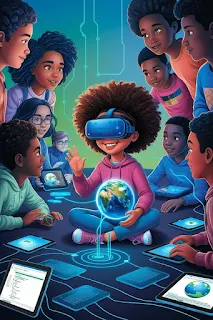7 Ways EdTech is Making Learning More Inclusive
Introduction: A New Era of Learning for Everyone
The landscape of education in 2025 looks drastically different, and much of that change can be attributed to EdTech. With its power to remove barriers, customise learning, and offer new ways to engage, EdTech is ensuring that inclusivity is no longer a dream but a reality. Today, students from all backgrounds, abilities, and locations are getting opportunities to learn and thrive like never before. Let's explore how EdTech is making education more inclusive for every learner.
1. Customised Learning Paths for Every Student
One-size-fits-all education is a thing of the past. Thanks to adaptive learning technologies and AI-driven platforms, students today can follow customised learning journeys tailored to their strengths, weaknesses, and learning styles. Whether a student needs extra help with maths or is excelling in science, EdTech adapts in real-time, ensuring that every learner gets the support or challenge they need. This personalisation ensures no student is left behind.
2. Greater Accessibility for Students with Disabilities
In 2025, EdTech tools are truly breaking down barriers for students with disabilities. From screen readers and voice-to-text applications to virtual sign language interpreters and captioned videos, technology is creating environments where students with visual, auditory, cognitive, or mobility impairments can access learning materials with ease. This means a more equitable experience where every student can participate fully in the learning process.
3. Language Barriers Are No Longer a Limitation
Global classrooms are more common now, and EdTech is ensuring that language differences don't hinder learning. Real-time translation tools, multilingual interfaces, and AI-driven language assistants allow students to access educational content in their preferred language. This is particularly transformative for refugee children, international students, and those from multilingual households, making education truly borderless and inclusive.
4. Affordable Learning Resources for All
Traditionally, high-quality education was often reserved for those who could afford expensive textbooks, tutors, or private schools. EdTech is democratising access by offering free or low-cost learning platforms, open educational resources (OERs), and online courses. In 2025, a student with only a basic smartphone and internet connection can tap into world-class knowledge, levelling the playing field like never before.
5. Flexible Learning Environments
Not every student thrives in a traditional classroom setting. Some need more time, others need a quieter space, and some need to balance learning with work or family responsibilities. EdTech offers asynchronous learning options, online courses, and hybrid classroom models that give students the flexibility to learn at their own pace and in environments where they feel comfortable. Flexibility fosters inclusion, ensuring that education fits the learner—not the other way around.
6. Building Confidence Through Interactive Learning
Interactive EdTech tools like gamified learning apps, VR experiences, and simulation-based training make education more engaging and less intimidating. These tools encourage participation from students who may otherwise feel shy, anxious, or underconfident in traditional classroom discussions. By creating safe, stimulating environments, EdTech empowers every student to have a voice, building confidence and encouraging active participation.
7. Community Building and Peer Collaboration
EdTech platforms are brilliant at connecting students beyond their immediate surroundings. Online forums, peer-to-peer collaboration tools, and group project platforms enable students from diverse backgrounds to work together, share ideas, and learn from each other's experiences. This promotes empathy, cultural awareness, and the building of inclusive communities where diversity is celebrated rather than seen as a barrier.
Conclusion: EdTech Is the Great Equaliser
The future of education is inclusive, and EdTech is leading the charge. From personalised learning and accessibility tools to affordable resources and global connectivity, technology is creating a world where education truly belongs to everyone. In 2025 and beyond, EdTech is not just a tool for learning—it’s a bridge to opportunity, empowerment, and equality.
By embracing these innovations, we’re not only improving education; we’re transforming lives and creating a more just, connected, and compassionate world.










